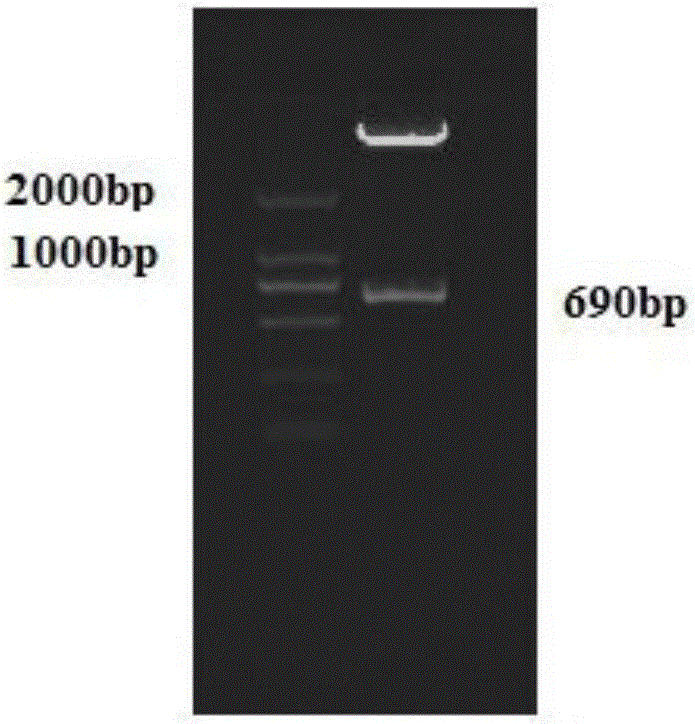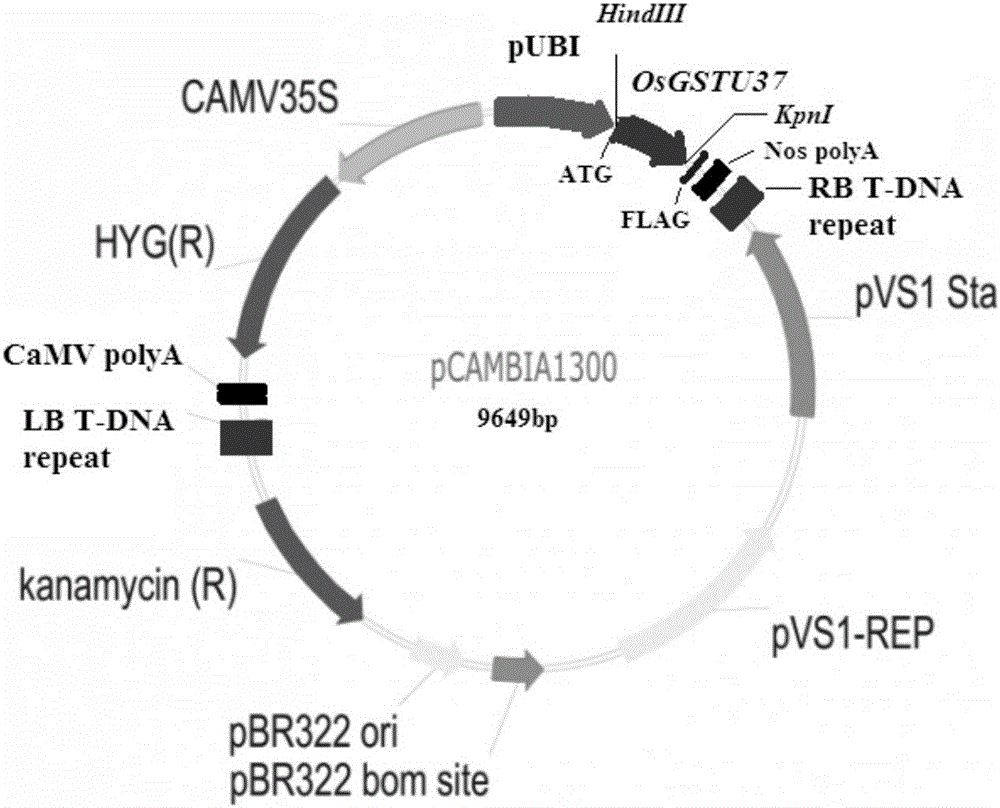Rice cadmium-tolerant gene OsGSTU37 and application thereof
A cadmium-resistant gene technology, applied in the fields of biotechnology and crop genetic engineering, can solve the problems of rice cadmium-tolerant ability and cadmium accumulation ability difference
- Summary
- Abstract
- Description
- Claims
- Application Information
AI Technical Summary
Problems solved by technology
Method used
Image
Examples
Embodiment 1
[0032] Example 1 Yeast ectopic expression of rice cadmium-tolerant gene OsGSTU37
[0033] Step 1. Design of primers
[0034]According to the whole genome sequence of rice variety Nipponbare (Oryzasativa Lcv. Nipponbare) provided by NCBI, the amplification primers were designed according to the coding region (CDS) sequence (SEQ ID NO: 3) of the rice cadmium-tolerant gene OsGSTU37, and restriction sites were added to the primers .
[0035] Specifically designed primers are: forward primer (SEQIDNO: 4) with NcoI at the 5' end, restriction site (CCATGG), reverse primer (SEQ ID NO: 5) with BamHI at the 5' end, restriction site (GGATCC), The primer sequences are as follows:
[0036] Forward primer: CCATGGATGGCCGATCCGGTTAAGCTCANcoI
[0037] Reverse primer: GGATCCCTGATGCACCATCGCCCTGAACBamHI
[0038] Step 2 Acquisition of gene OsGSTU37
[0039] Using rice cDNA as a template, the gene OsGSTU37 was amplified using the above-mentioned forward primer and reverse primer. The enzyme use...
Embodiment 2
[0060] Example 2 Obtaining of Overexpression Line of Rice Cadmium-tolerant Gene OsGSTU37
[0061] 1.1, the construction of the overexpression vector of gene OsGSTU37
[0062] Step 1. Design of primers
[0063] According to the whole genome sequence of rice variety Nipponbare (Oryzasativa Lcv. Nipponbare) provided by NCBI, the amplification primers were designed according to the CDS (SEQ ID NO: 3) sequence of the rice cadmium-tolerant gene OsGSTU37, and the enzyme cutting sites of the primers were designed according to the selected vector.
[0064] The overexpression vector was constructed using pCAMBIA1300, the entire coding frame of the vector was driven by the maize Ubiquitin gene promoter and fused with FLAG tag. Specifically designed primers are: forward primer (SEQ ID NO: 6) with HindIII at the 5' end, restriction site (AAGCTT), reverse primer (SEQ ID NO: 7) with KpnI at the 5' end, restriction site (GGTACC), The primer sequences are as follows:
[0065] Forward primer...
Embodiment 3
[0089] Example 3 Obtaining of rice cadmium-tolerant gene OsGSTU37 knockout line
[0090] 1.1 Construction of rice cadmium tolerance gene OsGSTU37 knockout vector
[0091] According to the whole genome sequence of rice variety Nipponbare (Oryzasativa Lcv. Nipponbare) provided by NCBI, and according to the sequence of rice cadmium-tolerant gene OsGSTU37, a target site KO (SEQ ID NO: 12) primer was designed on the exon of the gene, and the target site When designing the point, pay attention to the requirement that the PAM sequence of the last site is NGG, and the primer sequence is as follows (SEQ ID NO:13-14):
[0092] KOFP:TGTGTACTGGAGGCACAGCTCGAG
[0093] KORP:AAACCTCGAGCTGTGCCTCCAGTA
[0094] After the primers are fully dissolved, anneal the primers according to the system in Table 1.
[0095] Table 1 Primer annealing system
[0096]
[0097] Reaction conditions: 37°C, 1h.
[0098] Add 2.5ul 1M NaCl, 95°C, 5s. Turn off the incubator and let it anneal naturally for 2-...
PUM
 Login to View More
Login to View More Abstract
Description
Claims
Application Information
 Login to View More
Login to View More - R&D
- Intellectual Property
- Life Sciences
- Materials
- Tech Scout
- Unparalleled Data Quality
- Higher Quality Content
- 60% Fewer Hallucinations
Browse by: Latest US Patents, China's latest patents, Technical Efficacy Thesaurus, Application Domain, Technology Topic, Popular Technical Reports.
© 2025 PatSnap. All rights reserved.Legal|Privacy policy|Modern Slavery Act Transparency Statement|Sitemap|About US| Contact US: help@patsnap.com



